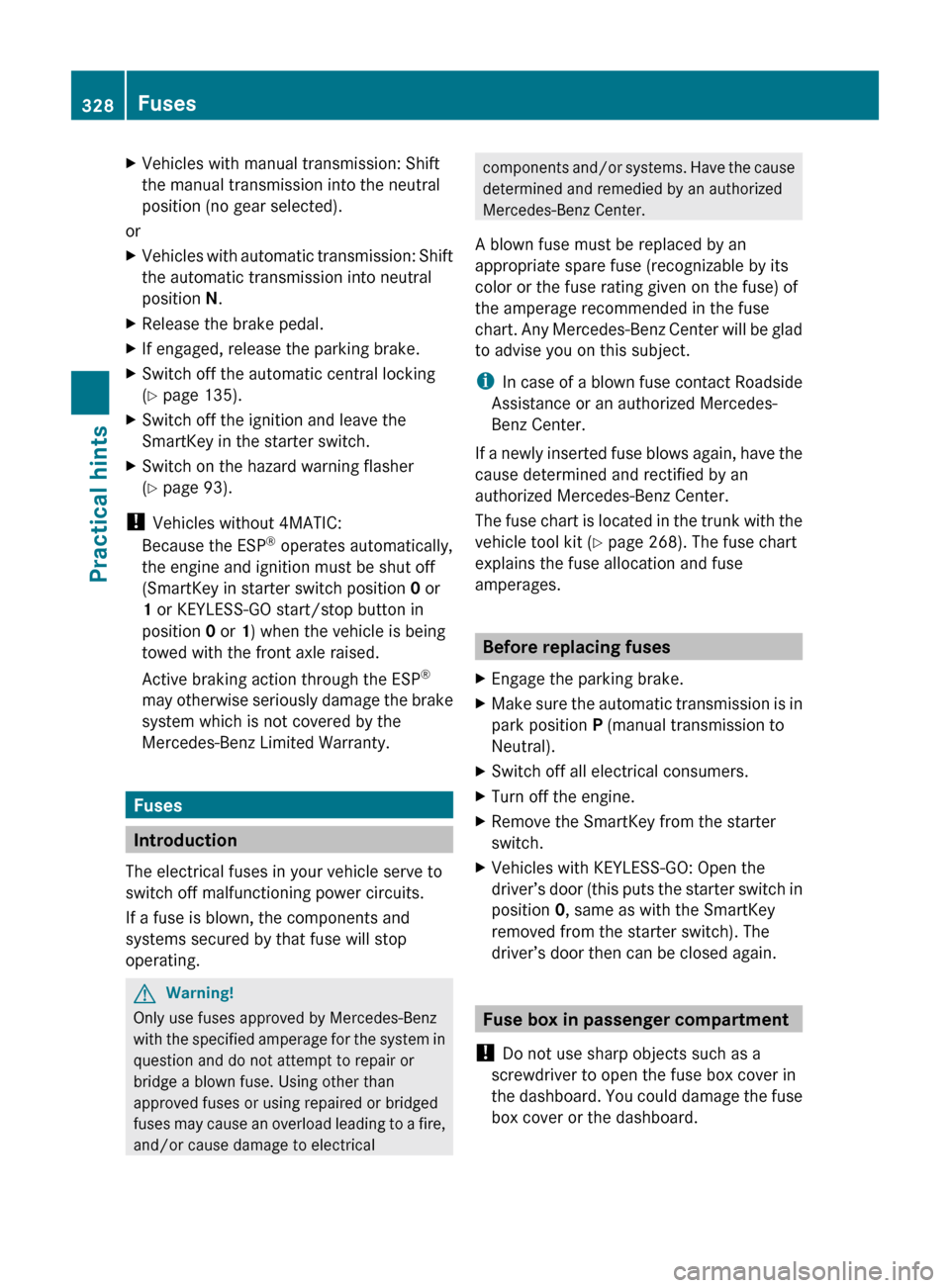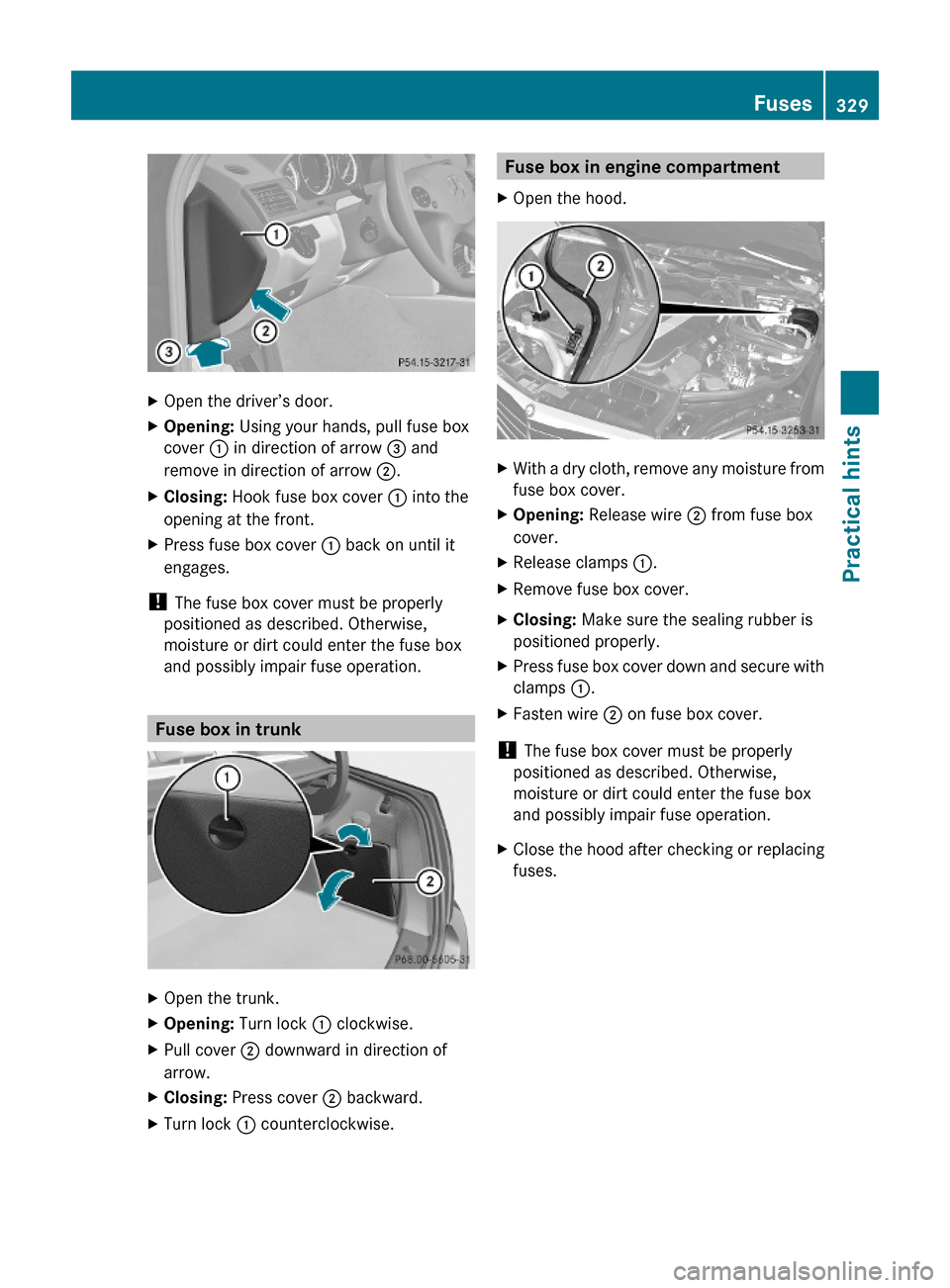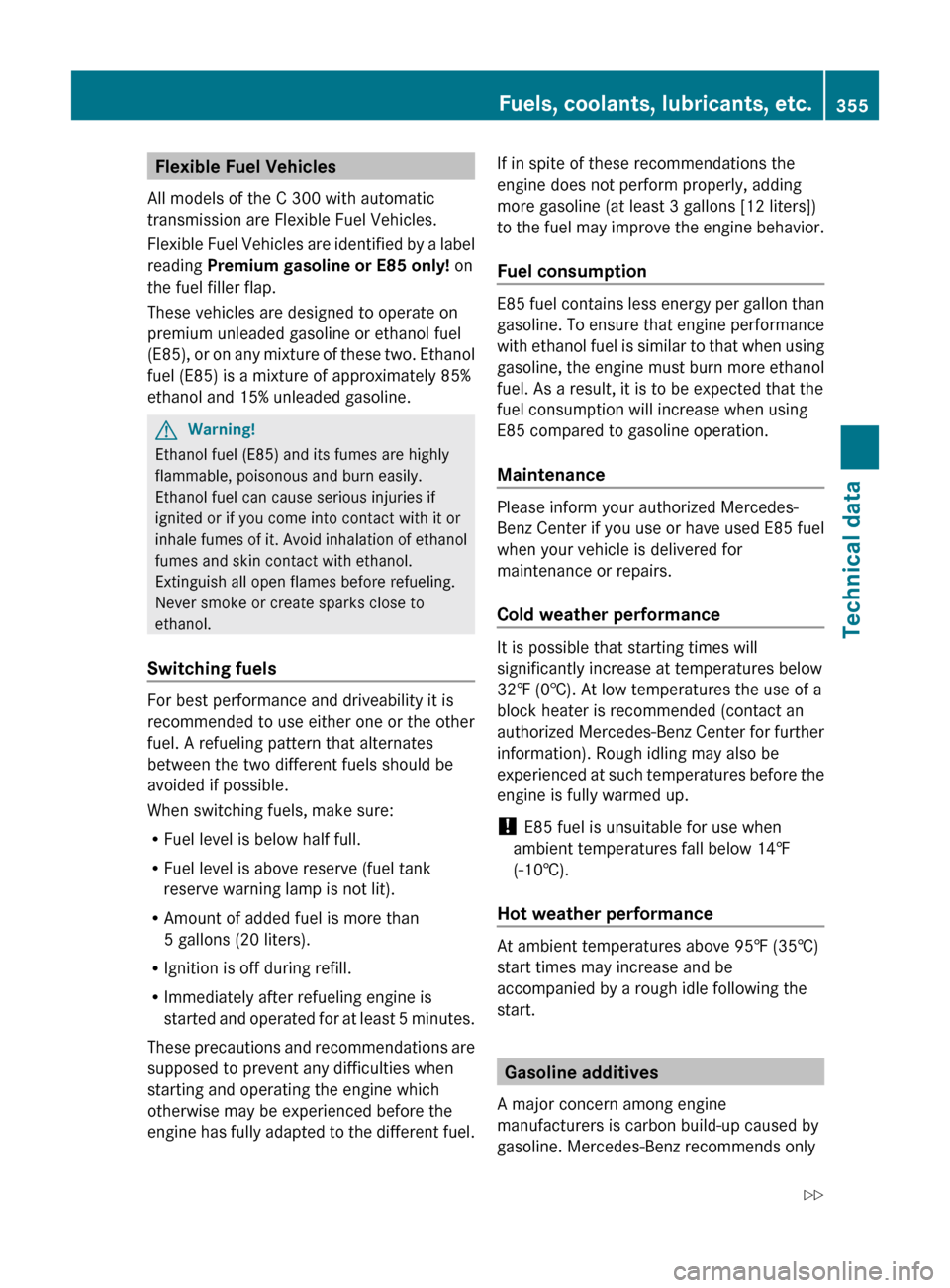2010 MERCEDES-BENZ C300 4MATIC lock
[x] Cancel search: lockPage 329 of 364

Removing towing eye boltXLoosen towing eye bolt ; by turning it
counterclockwise.XUnscrew towing eye bolt ;.XStore the towing eye bolt ; and wheel
wrench back into the vehicle tool kit.
Towing with all wheels on the ground
GWarning!
If circumstances require towing the vehicle
with all wheels on the ground, always tow with
a tow bar if:
R the engine will not run
R there is a malfunction in the brake system
R there is a malfunction in the power supply
or in the vehicle’s electrical system
This is necessary to adequately control the
towed vehicle.
Prior to towing the vehicle with all wheels on
the ground, make sure the SmartKey is in
starter switch position 2.
If the SmartKey is left in the starter switch
position 0 for an extended period of time, it
can no longer be turned in the switch. In this
case, the steering is locked. To unlock,
remove SmartKey from starter switch and
reinsert.
GWarning!
With the engine not running, there is no power
assistance for the brake and steering
systems. In this case, it is important to keep
in mind that a considerably higher degree of
effort is necessary to brake and steer the
vehicle. Adapt your driving accordingly.
XMake sure the ignition is switched on.XWith the vehicle at a standstill, depress the
brake pedal and keep it pressed.XVehicles with manual transmission: Shift
the manual transmission into the neutral
position (no gear selected).
or
XVehicles with automatic transmission: Shift
the automatic transmission into neutral
position N.XRelease the brake pedal.XIf engaged, release the parking brake.XSwitch on the hazard warning flasher
( Y page 93).
!
The vehicle may be towed only for
distances up to 30 miles (50 km) and at a
speed not to exceed 30 mph (50 km/h).
i While being towed with the hazard
warning flasher in use, use the combination
switch in the usual manner to signal turns.
Only the selected turn signal will operate.
Upon canceling the turn signal, the hazard
warning flasher will operate again.
Towing with front axle raised
! The vehicle may be towed only for
distances up to 30 miles (50 km) and at a
speed not to exceed 30 mph (50 km/h).
! Vehicles with 4MATIC: Do not tow with
one axle raised. Doing so could damage the
transfer case, which is not covered by the
Mercedes-Benz Limited Warranty.
All wheels must be on or off the ground.
Observe instructions for towing the vehicle
with all wheels on the ground.
XMake sure the ignition is switched on.XWith the vehicle at a standstill, depress the
brake pedal and keep it pressed.Towing the vehicle327Practical hints204_AKB; 5; 23, en-USd2ureepe,Version: 2.11.8.12009-07-16T17:54:06+02:00 - Seite 327Z
Page 330 of 364

XVehicles with manual transmission: Shift
the manual transmission into the neutral
position (no gear selected).
or
XVehicles with automatic transmission: Shift
the automatic transmission into neutral
position N.XRelease the brake pedal.XIf engaged, release the parking brake.XSwitch off the automatic central locking
( Y page 135).XSwitch off the ignition and leave the
SmartKey in the starter switch.XSwitch on the hazard warning flasher
( Y page 93).
!
Vehicles without 4MATIC:
Because the ESP ®
operates automatically,
the engine and ignition must be shut off
(SmartKey in starter switch position 0 or
1 or KEYLESS-GO start/stop button in
position 0 or 1) when the vehicle is being
towed with the front axle raised.
Active braking action through the ESP ®
may otherwise seriously damage the brake
system which is not covered by the
Mercedes-Benz Limited Warranty.
Fuses
Introduction
The electrical fuses in your vehicle serve to
switch off malfunctioning power circuits.
If a fuse is blown, the components and
systems secured by that fuse will stop
operating.
GWarning!
Only use fuses approved by Mercedes-Benz
with the specified amperage for the system in
question and do not attempt to repair or
bridge a blown fuse. Using other than
approved fuses or using repaired or bridged
fuses may cause an overload leading to a fire,
and/or cause damage to electrical
components and/or systems. Have the cause
determined and remedied by an authorized
Mercedes-Benz Center.
A blown fuse must be replaced by an
appropriate spare fuse (recognizable by its
color or the fuse rating given on the fuse) of
the amperage recommended in the fuse
chart. Any Mercedes-Benz Center will be glad
to advise you on this subject.
i In case of a blown fuse contact Roadside
Assistance or an authorized Mercedes-
Benz Center.
If a newly inserted fuse blows again, have the
cause determined and rectified by an
authorized Mercedes-Benz Center.
The fuse chart is located in the trunk with the
vehicle tool kit ( Y page 268). The fuse chart
explains the fuse allocation and fuse
amperages.
Before replacing fuses
XEngage the parking brake.XMake sure the automatic transmission is in
park position P (manual transmission to
Neutral).XSwitch off all electrical consumers.XTurn off the engine.XRemove the SmartKey from the starter
switch.XVehicles with KEYLESS-GO: Open the
driver’s door (this puts the starter switch in
position 0, same as with the SmartKey
removed from the starter switch). The
driver’s door then can be closed again.
Fuse box in passenger compartment
! Do not use sharp objects such as a
screwdriver to open the fuse box cover in
the dashboard. You could damage the fuse
box cover or the dashboard.
328FusesPractical hints
204_AKB; 5; 23, en-USd2ureepe,Version: 2.11.8.12009-07-16T17:54:06+02:00 - Seite 328
Page 331 of 364

XOpen the driver’s door.XOpening: Using your hands, pull fuse box
cover : in direction of arrow = and
remove in direction of arrow ;.
XClosing: Hook fuse box cover : into the
opening at the front.
XPress fuse box cover : back on until it
engages.
! The fuse box cover must be properly
positioned as described. Otherwise,
moisture or dirt could enter the fuse box
and possibly impair fuse operation.
Fuse box in trunk
XOpen the trunk.XOpening: Turn lock : clockwise.XPull cover ; downward in direction of
arrow.
XClosing: Press cover ; backward.XTurn lock : counterclockwise.Fuse box in engine compartmentXOpen the hood.XWith a dry cloth, remove any moisture from
fuse box cover.
XOpening: Release wire ; from fuse box
cover.
XRelease clamps :.XRemove fuse box cover.XClosing: Make sure the sealing rubber is
positioned properly.
XPress fuse box cover down and secure with
clamps :.
XFasten wire ; on fuse box cover.
! The fuse box cover must be properly
positioned as described. Otherwise,
moisture or dirt could enter the fuse box
and possibly impair fuse operation.
XClose the hood after checking or replacing
fuses.
Fuses329Practical hints204_AKB; 5; 23, en-USd2ureepe,Version: 2.11.8.12009-07-16T17:54:06+02:00 - Seite 329Z
Page 357 of 364

Flexible Fuel Vehicles
All models of the C 300 with automatic
transmission are Flexible Fuel Vehicles.
Flexible Fuel Vehicles are identified by a label
reading Premium gasoline or E85 only! on
the fuel filler flap.
These vehicles are designed to operate on
premium unleaded gasoline or ethanol fuel
(E85), or on any mixture of these two. Ethanol
fuel (E85) is a mixture of approximately 85%
ethanol and 15% unleaded gasoline.GWarning!
Ethanol fuel (E85) and its fumes are highly
flammable, poisonous and burn easily.
Ethanol fuel can cause serious injuries if
ignited or if you come into contact with it or
inhale fumes of it. Avoid inhalation of ethanol
fumes and skin contact with ethanol.
Extinguish all open flames before refueling.
Never smoke or create sparks close to
ethanol.
Switching fuels
For best performance and driveability it is
recommended to use either one or the other
fuel. A refueling pattern that alternates
between the two different fuels should be
avoided if possible.
When switching fuels, make sure:
R Fuel level is below half full.
R Fuel level is above reserve (fuel tank
reserve warning lamp is not lit).
R Amount of added fuel is more than
5 gallons (20 liters).
R Ignition is off during refill.
R Immediately after refueling engine is
started and operated for at least 5 minutes.
These precautions and recommendations are
supposed to prevent any difficulties when
starting and operating the engine which
otherwise may be experienced before the
engine has fully adapted to the different fuel.
If in spite of these recommendations the
engine does not perform properly, adding
more gasoline (at least 3 gallons [12 liters])
to the fuel may improve the engine behavior.
Fuel consumption
E85 fuel contains less energy per gallon than
gasoline. To ensure that engine performance
with ethanol fuel is similar to that when using
gasoline, the engine must burn more ethanol
fuel. As a result, it is to be expected that the
fuel consumption will increase when using
E85 compared to gasoline operation.
Maintenance
Please inform your authorized Mercedes-
Benz Center if you use or have used E85 fuel
when your vehicle is delivered for
maintenance or repairs.
Cold weather performance
It is possible that starting times will
significantly increase at temperatures below
32‡ (0†). At low temperatures the use of a
block heater is recommended (contact an
authorized Mercedes-Benz Center for further
information). Rough idling may also be
experienced at such temperatures before the
engine is fully warmed up.
! E85 fuel is unsuitable for use when
ambient temperatures fall below 14‡
(-10†).
Hot weather performance
At ambient temperatures above 95‡ (35†)
start times may increase and be
accompanied by a rough idle following the
start.
Gasoline additives
A major concern among engine
manufacturers is carbon build-up caused by
gasoline. Mercedes-Benz recommends only
Fuels, coolants, lubricants, etc.355Technical data204_AKB; 5; 23, en-USd2ureepe,Version: 2.11.8.12009-07-16T17:54:06+02:00 - Seite 355Z